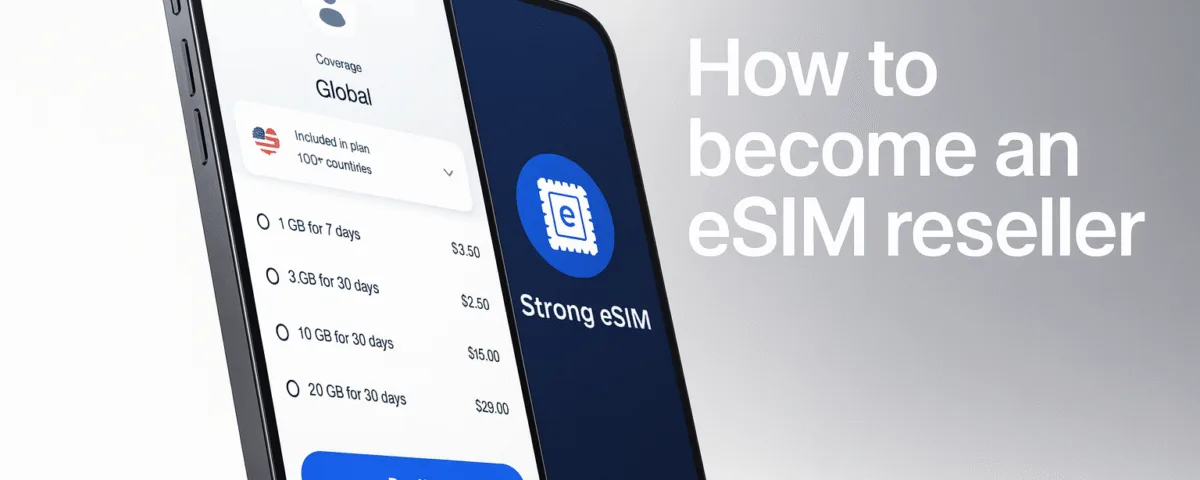
The Fastest Way to Sell eSIMs Online: Meet Our WordPress Plugin
julio 18, 2025
Finding Henof.com Tech: A Funny Kids Guide
septiembre 15, 2025The world of telecommunications is rapidly evolving, and eSIM technology is at the forefront of this transformation. As traditional SIM cards make way for embedded SIMs, or eSIMs, a new avenue of business opportunities is opening for tech-savvy entrepreneurs. Understanding how to tap into this burgeoning market could put you ahead in a digital-first economy.
An eSIM, or embedded SIM, is a small chip inside a device that replaces the need for a physical SIM card, enabling seamless connectivity across networks without swapping cards. This innovation not only simplifies user experience but also ushers in new business possibilities, including the potential to become an eSIM reseller. From partnering with suppliers to owning an eSIM platform, the scope of becoming an eSIM entrepreneur is vast and lucrative.
In this article, we will guide you through the process of becoming an eSIM reseller. You will learn about the necessary steps to enter the digital reseller market, understand who supplies eSIMs, and explore how to establish an eSIM business. Whether you are exploring the feasibility of selling phones with eSIMs or seeking ways to integrate eSIM solutions into your offerings, this detailed guide will set you on the path to a successful eSIM venture.
How to become a digital reseller?
Becoming a digital reseller involves several strategic steps to establish a successful business in the digital realm. Here’s a concise guide to help you get started:
- Identify Your Niche: Determine the products or services you want to resell. This could include eSIM technology, software solutions, or digital marketing tools.
- Research Suppliers: Partner with reliable suppliers or service providers. Establish connections with Mobile Network Operators or local carriers to offer products like white-label eSIMs.
- Create a Business Plan: Outline your marketing strategy, target audience, and financial projections. A solid plan should include details about pricing, reseller platforms, and potential customer support.
- Set Up Your Platform: Develop a user-friendly platform for order processing. Integrate APIs for seamless eSIM delivery and data package customization.
- Product Knowledge: Stay informed about product features such as eSIM profiles, QR codes, and device compatibility.
- Launch Your Reseller Program: Use a White Label eSIM Store to provide a personalized service. Focus on improving customer experience and minimizing roaming charges for travel agencies and tour operators.
By following these steps, you can effectively enter the digital reselling market and provide valuable solutions to your customers.
Who supplies eSIM?
The eSIM (embedded SIM) technology has gained popularity thanks to its ability to simplify and enhance mobile connectivity. Various entities supply eSIMs, catering to different customer requirements.
- Mobile Network Operators (MNOs): MNOs are primary suppliers of eSIMs, providing them as part of their service offerings. They often integrate this technology into their plans to reduce roaming charges and enhance customer experiences.
- Local Carriers: Local carriers supply eSIMs that are ideal for travelers needing local rates without the hassle of swapping physical SIM cards. They typically offer attractive data bundles tailored to specific regions.
- Specialized eSIM Providers: These companies focus exclusively on eSIM technology, supporting travel agents, tour operators, and travel agencies with customer-friendly data packages and delivery options via QR codes or APIs.
- eSIM Reseller Platforms: These platforms facilitate white-label eSIM solutions for businesses, allowing them to sell eSIMs with customizable profiles, data allowances, and tailored marketing strategies.
Suppliers and Services
| Supplier Type | Key Services |
|---|---|
| MNOs | Comprehensive mobile plans, data usage monitoring |
| Local Carriers | Region-specific data packages, competitive local rates |
| Specialized eSIM Providers | eSIM delivery, API integration, device compatibility support |
| eSIM Reseller Platforms | White-label solutions, reseller programs, customer experience enhancement |
These suppliers ensure a seamless and flexible telecommunication experience by leveraging eSIM technology to meet diverse user needs worldwide.
How to own an eSIM?
Owning an eSIM, or digital SIM card, can streamline your connectivity experience, particularly for frequent travelers or digital nomads. Here’s a step-by-step guide on how to own an eSIM:
- Check Device Compatibility: Ensure your device supports eSIM technology. Most modern smartphones and tablets include eSIM capabilities. Check the manufacturer’s specifications for compatibility details.
- Select a Provider: Choose a provider that offers eSIM services. Consider companies with competitive data packages and excellent customer support, such as travel agents or local carriers.
- Purchase a Plan: Once you’ve selected a provider, choose a data plan that suits your needs. Options range from global data packages to local plans with varying data allowances.
- Download eSIM Profile: After purchasing, you’ll receive a QR code. Scan it on your device to download and activate the eSIM profile.
- Configure Settings: Access your device’s mobile data settings to ensure the eSIM is configured correctly, then start using your data.
This process eliminates the need for physical SIM cards, offering seamless connectivity with reduced roaming charges, enhancing the travel experience. For businesses, participating in an B2B eSIM Reseller Program can be a strategic marketing decision, enabling them to offer eSIM solutions and improve customer experience.
How to create an eSIM platform?
Creating an eSIM platform involves several steps that ensure seamless customer experiences and efficient management for resellers. Here’s a concise guide to get you started:
- Research and Choose a Platform: Start by selecting a reputable white-label eSIM platform. Evaluate API integration capabilities and eSIM delivery methods to determine the best fit for your business needs.
- Set Up Your Reseller Platform: Customize your reseller platform with branding to attract customers, such as travel agencies and tour operators. Ensure your interface supports easy navigation and features customer support access.
- Partner with Mobile Network Operators: Collaborate with local carriers and Mobile Network Operators to secure competitive roaming charges and diverse data packages for your customers.
- Develop Data Packages: Curate data bundles catering to various data usage needs. Ensure offerings include flexible data allowances suitable for diverse travel experiences.
- Implement Marketing Strategy: Launch a targeted marketing strategy highlighting eSIM technology advantages over traditional SIM cards, emphasizing benefits like device compatibility and avoiding the hassle of physical local SIM cards.
- Monitor and Enhance Customer Experience: Regularly assess and refine the customer experience using feedback channels. Implement QR codes for easy eSIM profile installations and provide competent customer support to address issues swiftly.
By following these steps, you’ll create an effective eSIM platform that enhances the digital travel experience.
Can you make your own eSIM?
Creating your own eSIM is not straightforward due to the technical and regulatory complexities involved. eSIM technology is tightly controlled by Mobile Network Operators (MNOs) and local carriers, making it challenging for individuals to generate their own eSIM profiles. This process typically involves significant back-end integration with MNOs, including API Integration for managing eSIM profiles, activating data packages, and ensuring device compatibility.
However, some businesses engage in creating white-label eSIM solutions, allowing for a branded eSIM offering without the need for deep technical skills or network agreements. These B2B eSIM Reseller Programs enable travel agents and tour operators to offer digital SIM cards tailored for international travelers, reducing roaming charges and enhancing the travel experience.
Consider the following when exploring eSIM opportunities:
- Reseller Platforms: These platforms provide infrastructure for distributing eSIMs.
- White Label eSIM Store: Offers a customized solution for selling eSIMs under your brand.
- Customer Support: Essential for addressing issues related to QR codes and data allowance.
In summary, while individuals cannot generally create their own eSIMs, businesses have opportunities to offer eSIM technology through collaborative platforms and reseller programs.
How to directly buy eSIM?
Purchasing an eSIM directly involves a few straightforward steps, enabling users to seamlessly integrate digital SIM capabilities into their devices. Here’s a guide to help you purchase an eSIM:
- Check Device Compatibility: Ensure your device supports eSIM technology. Most modern smartphones have this feature, but it’s vital to verify compatibility first.
- Select a Provider: Choose from available eSIM providers. Many Mobile Network Operators and local carriers offer competitive deals on data packages and data allowances via eSIMs.
- Choose a Plan: Pick a suitable data bundle or roaming package. Consider factors like data usage, travel packages, and roaming charges, especially if you are traveling.
- Purchase Online: Buy your chosen eSIM plan through the provider’s website or mobile app. This often involves creating an account.
- Receive eSIM Profile: After purchasing, you’ll typically receive an eSIM profile, which involves a QR code delivered via email or an app.
- Activate: Open your phone’s settings and add a new cellular plan using the QR code or through the provided activation process.
By following these steps, you can quickly enjoy the benefits of an eSIM, enhancing your mobile data experience without dealing with physical SIM cards.
Who unlocks eSIM?
Unlocking an eSIM involves enabling the digital SIM card capability on a compatible device, allowing users to access mobile networks without a physical SIM card. This process is typically facilitated by Mobile Network Operators (MNOs) and local carriers. They manage the eSIM profiles, which are digital representations of the user’s mobile plan, enabling seamless switching between different network operators without the need to swap SIM cards.
Travel agencies and travel agents are increasingly offering travel eSIM solutions to enhance customer experience for travelers. An eSIM Reseller Program allows them to provide data packages tailored to travel experiences, avoiding traditional roaming charges and managing data usage more efficiently.
eSIM technology has transformed the way data bundles and mobile data are utilized. White-label eSIM platforms like Holafly, Airalo or Strong eSIM allow businesses to customize and offer eSIM services under their brand, integrating APIs for smooth eSIM delivery and customer support.
Device compatibility is essential, as only eSIM-enabled devices can support its profiles, activated via QR codes or direct API integration. The next time you travel, consider opting for a reseller platform offering eSIM technology for a convenient, flexible, and cost-effective mobile data solution.
Can I use an eSIM for business?
The advent of eSIM technology has revolutionized connectivity, making it an excellent choice for business use. With eSIM, businesses can seamlessly manage mobile data across various devices without the need for physical SIM cards. This technology is beneficial for business travelers who frequently face roaming charges, as eSIMs enable access to local carriers and data packages at competitive rates, improving overall travel experience and connectivity.
eSIMs also support increased data allowance and flexible data bundles, allowing businesses to choose plans that align with their specific data usage needs. This eliminates the hassle of carrying multiple local SIM cards or managing multiple billing accounts.
Additionally, eSIMs enhance device compatibility, supporting a wide range of mobile devices and integrating easily into existing mobile network operators’ infrastructures. Through API integration, businesses can streamline eSIM delivery and management effortlessly.
Here is a quick list of the advantages:
- Cost-Effective: Reduces roaming charges and enables access to local network plans.
- Flexibility: Easily switch between carriers and plans for optimal data usage.
- Convenience: No physical SIM card handling, resulting in streamlined operations.
In summary, eSIM technology is reshaping how businesses handle mobile connectivity, offering a more efficient and flexible solution for managing communications.
Can I sell a phone with an eSIM?
Yes, you can sell a phone with an eSIM, but there are several important factors to consider to ensure a seamless transaction for both seller and buyer.
Device Compatibility: Not all mobile devices support eSIM technology. Ensure that the phone you are selling is compatible with eSIM and verify that it can switch between digital SIM card and physical SIM functionalities, if necessary.
eSIM Profiles: Before selling your device, it is advisable to remove any pre-installed eSIM profiles. This can be done by going to the settings and selecting the option to delete or erase any eSIM data.
Customer Experience: Inform potential buyers about how to set up their own eSIM profiles. Highlight the convenience eSIM technology offers, such as avoiding roaming charges and the ability to easily switch local carriers when traveling.
Device Security: Perform a factory reset to ensure that all personal information and data profiles are secured and erased.
Reseller Strategy: For business sellers, integrating with an eSIM Reseller Platform can enhance the selling experience by offering data packages and QR codes for easy eSIM delivery.
By addressing these factors, you can facilitate a smooth and informative selling process.
Can someone buy eSIM for me?
Yes, someone can buy an eSIM for you, provided they have the necessary information and consent to do so. Here’s how it typically works:
- Information Sharing: You’ll need to share your device’s IMEI number and eSIM-compatible status with the person making the purchase. This ensures the eSIM profile can be properly activated on your device.
- eSIM Purchase: The buyer can purchase an eSIM from a recognized eSIM reseller or through a mobile network operator. Travel agencies or tour operators may also offer travel eSIMs as part of their travel packages.
- QR Code Delivery: After the purchase, the eSIM is delivered as a QR code, which you can scan into your device to activate the digital SIM card.
- Data Packages: The buyer can choose data packages according to your data usage needs. This flexibility can enhance your travel experience and prevent unnecessary roaming charges.
- Activation: Once you receive the QR code, simply scan it with your compatible device, and your eSIM will be activated.
This process ensures you have seamless mobile data access, enhancing convenience and flexibility in maintaining connectivity wherever you travel.
How to establish eSIM?
Establishing an eSIM involves several key steps, requiring technological understanding and partnerships. Here’s a concise guide to get you started:
- Research & Planning
Investigate eSIM technology, focusing on its integration, benefits, and potential challenges. Assess requirements like device compatibility and customer experience expectations. - Partnerships
Collaborate with Mobile Network Operators (MNOs) and local carriers. Consider joining an B2B eSIM Reseller Program that offers a White Label eSIM Store, allowing you to personalize the service. - Platform Selection
Choose a robust reseller platform. It should support scalable solutions, API integration, and offer QR codes for seamless eSIM delivery to enhance the customer experience. - Marketing Strategy
Develop a strategy tailored to target segments, such as travel agencies and tour operators. Highlight benefits like avoiding roaming charges and flexible data packages. - Customer Support
Set up an efficient system to handle inquiries, ensuring good customer support. Consider offering white-label eSIM services, providing customization options.
Essential Elements for eSIM Establishment
| Element | Importance |
|---|---|
| MNO Partnerships | Access global network coverage |
| Reseller Platform | Flexibility in delivery and management |
| API Integration | Streamlined service with easy updates |
| Marketing Strategy | Boost outreach and customer engagement |
By following these steps, you can successfully implement an eSIM system, enriching users’ travel experiences with seamless digital connectivity.
What is an eSIM business?
An eSIM business revolves around the sale and distribution of electronic SIM (eSIM) technology, streamlining mobile connectivity without the need for physical SIM cards. By adopting eSIM technology, businesses can offer customers a seamless experience in managing mobile data and connectivity, ideal for travelers and tech-savvy users.
Key aspects of an eSIM business include:
- eSIM Reseller Platform: A platform allowing resellers to manage and sell eSIM data packages with ease.
- White-Label eSIM: This involves offering customized eSIM solutions, allowing brands to present them as their own offerings.
- API Integration: Integrating eSIM services with existing systems to enhance customer experience.
- Device Compatibility: Ensuring eSIM profiles are compatible with various devices, enhancing user convenience.
- Travel Packages: Offering travel eSIM packages that avoid expensive roaming charges using local carrier partnerships.
- Customer Support: Providing round-the-clock assistance to address customer inquiries and technical issues.
A typical eSIM business not only focuses on providing digital SIM cards but also collaborates with mobile network operators and tour operators to enhance market outreach. With QR codes for easy eSIM delivery, these businesses enable efficient customer journeys across global destinations, ensuring superior data usage management and connectivity.




